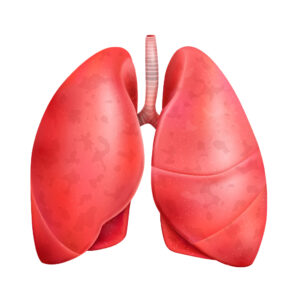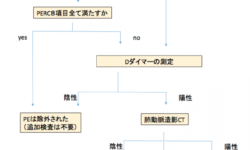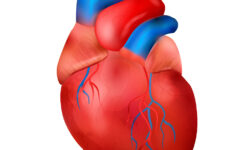1.メカニズム
(1) 小さくしなやかな鼻カヌラにより患者の快適性が向上する。
(2) 高度な加温加湿機能により、痰の含有水分量が増加し、痰が除去されやすい。また、気道の乾燥やそれによる粘膜損傷が起きにくい。その結果、呼吸作業量を減少し、患者の快適さが向上する[1,2]。
(3) 鼻咽腔の死腔を洗い流すことにより、同じ分時換気量でも肺胞換気にあずかる換気量が増加し、酸素化と換気が改善する[3-5]。
(4) 鼻咽腔の圧が上がることによりPEEPがかかるため、オートピープがある場合はこれを解除し、呼吸作業量は減少され、酸素化が改善される[6~12]。口を閉じていると10L/minにつきPEEP=0.7cm上昇し、口を開いていると10L/minにつき0.35cm上昇する。
(5) 本人の換気量に負けない高流量により室内気の取り込みが防止され、FiO2の安定供給や、呼吸パターンが改善する(換気量の増加、呼吸数の減少)[13-15]。ただし口が開いていると多少の室内気が混じる。
2.パラメータの設定
「流量」と「FiO2」の2つのパラメータを設定する。
最初は20~35 L/分(最小5~最大60 L/minute)で開始する。FiO2は患者のSpP2をみながらセットする。
頻呼吸が改善しない or 酸素化が改善しない or 努力呼吸が改善しない、などの状況があれば、流量を5~10 L/分ずつ増加させる。
できるだけFiO2を60%以下に維持するが、状況に応じて60%以上にアップする。HFNCは数日間とくに問題なく継続できるが、ウイーニングの結果、流量が20 L/分およびFiO2が50%以下になったら通常のマスクなどに交換する。
3.適応
 以前であればベンチュリーマスクやNIPPVが使用されていた症例の多くに、代用としてHFNCが利用可能である。
以前であればベンチュリーマスクやNIPPVが使用されていた症例の多くに、代用としてHFNCが利用可能である。
HFNCの絶対適応はないが、主に、中~低炭酸ガス血症を伴うP/F比300以下の低酸素血症に対して使用される。
低酸素血症の患者にHFNCを導入すると、酸素化、呼吸数、心拍数などの呼吸パラメータが改善したという報告は多い[16-28]。
しかしICU滞在期間や死亡率といったより臨床的なアウトカムが改善したというデータは今のところ少ない。
高炭酸ガス血症に対しては基本的には使用しない。
高PEEPが必要なARDSなどにも使用できない。また、HFNCを過信して粘り過ぎることで気管挿管のタイミングを遅らせたり予後を悪化させたりする可能性があるので[29]、HFNC設置後30分経っても頻呼吸が増悪する場合や、1時間経っても酸素化が改善しない場合は、躊躇せずに気管挿管を検討する[30]。
その他、HFNCは抜管後のサポート、挿管直前の酸素化[31-34]、および挿管管理中の酸素化[34]、気管支鏡施行中の呼吸管理[35,36]、などに有用性が示されている。
HFNCとネブライザーの同時使用は研究されていないが、ネブライザーはカヌラから投与できないので口から投与するしかない。しかし有効なネブライザー効果が得られるか否かは不明である。
(文責:新井隆男)
◇◆◇
(参考文献)
1. Williams R, Rankin N, Smith T, et al. Relationship between the humidity and temperature of inspired gas and the function of the airway mucosa. Crit Care Med 1996; 24:1920.
2. Hasani A, Chapman TH, McCool D, et al. Domiciliary humidification improves lung mucociliary clearance in patients with bronchiectasis. Chron Respir Dis 2008; 5:81.
3. Sztrymf B, Messika J, Mayot T, et al. Impact of high-flow nasal cannula oxygen therapy on intensive care unit patients with acute respiratory failure: a prospective observational study. J Crit Care 2012; 27:324.e9.
4. Sztrymf B, Messika J, Bertrand F, et al. Beneficial effects of humidified high flow nasal oxygen in critical care patients: a prospective pilot study. Intensive Care Med 2011; 37:1780.
5. Lenglet H, Sztrymf B, Leroy C, et al. Humidified high flow nasal oxygen during respiratory failure in the emergency department: feasibility and efficacy. Respir Care 2012; 57:1873.
6. Parke RL, McGuinness SP. Pressures delivered by nasal high flow oxygen during all phases of the respiratory cycle. Respir Care 2013; 58:1621.
7. Parke RL, Eccleston ML, McGuinness SP. The effects of flow on airway pressure during nasal high-flow oxygen therapy. Respir Care 2011; 56:1151.
8. Sim MA, Dean P, Kinsella J, et al. Performance of oxygen delivery devices when the breathing pattern of respiratory failure is simulated. Anaesthesia 2008; 63:938.
9. Groves N, Tobin A. High flow nasal oxygen generates positive airway pressure in adult volunteers. Aust Crit Care 2007; 20:126.
10. Br?unlich J, Beyer D, Mai D, et al. Effects of nasal high flow on ventilation in volunteers, COPD and idiopathic pulmonary fibrosis patients. Respiration 2013; 85:319.
11. Parke R, McGuinness S, Eccleston M. Nasal high-flow therapy delivers low level positive airway pressure. Br J Anaesth 2009; 103:886.
12. Corley A, Caruana LR, Barnett AG, et al. Oxygen delivery through high-flow nasal cannulae increase end-expiratory lung volume and reduce respiratory rate in post-cardiac surgical patients. Br J Anaesth 2011; 107:998.
13. Ritchie JE, Williams AB, Gerard C, Hockey H. Evaluation of a humidified nasal high-flow oxygen system, using oxygraphy, capnography and measurement of upper airway pressures. Anaesth Intensive Care 2011; 39:1103.
14. Wagstaff TA, Soni N. Performance of six types of oxygen delivery devices at varying respiratory rates. Anaesthesia 2007; 62:492.
15. Riera J, P?rez P, Cort?s J, et al. Effect of high-flow nasal cannula and body position on end-expiratory lung volume: a cohort study using electrical impedance tomography. Respir Care 2013; 58:589.
16. Roca O, Riera J, Torres F, Masclans JR. High-flow oxygen therapy in acute respiratory failure. Respir Care 2010; 55:408.
17. Jones PG, Kamona S, Doran O, et al. Randomized Controlled Trial of Humidified High-Flow Nasal Oxygen for Acute Respiratory Distress in the Emergency Department: The HOT-ER Study. Respir Care 2016; 61:291.
18. Frat JP, Thille AW, Mercat A, et al. High-flow oxygen through nasal cannula in acute hypoxemic respiratory failure. N Engl J Med 2015; 372:2185.
19. Frat JP, Ragot S, Girault C, et al. Effect of non-invasive oxygenation strategies in immunocompromised patients with severe acute respiratory failure: a post-hoc analysis of a randomised trial. Lancet Respir Med 2016; 4:646.
20. Lemiale V, Resche-Rigon M, Mokart D, et al. High-Flow Nasal Cannula Oxygenation in Immunocompromised Patients With Acute Hypoxemic Respiratory Failure: A Groupe de Recherche Respiratoire en R?animation Onco-H?matologique Study. Crit Care Med 2017; 45:e274.
21. Rello J, P?rez M, Roca O, et al. High-flow nasal therapy in adults with severe acute respiratory infection: a cohort study in patients with 2009 influenza A/H1N1v. J Crit Care 2012; 27:434.
22. Lee HY, Rhee CK, Lee JW. Feasibility of high-flow nasal cannula oxygen therapy for acute respiratory failure in patients with hematologic malignancies: A retrospective single-center study. J Crit Care 2015; 30:773.
23. Roca O, de Acilu MG, Caralt B, et al. Humidified high flow nasal cannula supportive therapy improves outcomes in lung transplant recipients readmitted to the intensive care unit because of acute respiratory failure. Transplantation 2015; 99:1092.
24. Carratal? Perales JM, Llorens P, Brouzet B, et al. High-Flow therapy via nasal cannula in acute heart failure. Rev Esp Cardiol 2011; 64:723.
25. Messika J, Ben Ahmed K, Gaudry S, et al. Use of High-Flow Nasal Cannula Oxygen Therapy in Subjects With ARDS: A 1-Year Observational Study. Respir Care 2015; 60:162.
26. Calvano TP, Sill JM, Kemp KR, Chung KK. Use of a high-flow oxygen delivery system in a critically ill patient with dementia. Respir Care 2008; 53:1739.
27. Boyer A, Vargas F, Delacre M, et al. Prognostic impact of high-flow nasal cannula oxygen supply in an ICU patient with pulmonary fibrosis complicated by acute respiratory failure. Intensive Care Med 2011; 37:558.
28. Lacroix G, Pons F, D’Aranda E, et al. High-flow oxygen, a therapeutic bridge while awaiting thrombolysis in pulmonary embolism? Am J Emerg Med 2013; 31:463.e1.
29. Kang BJ, Koh Y, Lim CM, et al. Failure of high-flow nasal cannula therapy may delay intubation and increase mortality. Intensive Care Med 2015; 41:623.
30. Sztrymf B, Messika J, Mayot T, et al. Impact of high-flow nasal cannula oxygen therapy on intensive care unit patients with acute respiratory failure: a prospective observational study. J Crit Care 2012; 27:324.e9.
31. Jaber S, Monnin M, Girard M, et al. Apnoeic oxygenation via high-flow nasal cannula oxygen combined with non-invasive ventilation preoxygenation for intubation in hypoxaemic patients in the intensive care unit: the single-centre, blinded, randomised controlled OPTINIV trial. Intensive Care Med 2016; 42:1877.
32. Miguel-Montanes R, Hajage D, Messika J, et al. Use of high-flow nasal cannula oxygen therapy to prevent desaturation during tracheal intubation of intensive care patients with mild-to-moderate hypoxemia. Crit Care Med 2015; 43:574.
33. Vourc’h M, Asfar P, Volteau C, et al. High-flow nasal cannula oxygen during endotracheal intubation in hypoxemic patients: a randomized controlled clinical trial. Intensive Care Med 2015; 41:1538.
34. Semler MW, Janz DR, Lentz RJ, et al. Randomized Trial of Apneic Oxygenation during Endotracheal Intubation of the Critically Ill. Am J Respir Crit Care Med 2016; 193:273.
35. Miyagi K, Haranaga S, Higa F, et al. Implementation of bronchoalveolar lavage using a high-flow nasal cannula in five cases of acute respiratory failure. Respir Investig 2014; 52:310.
36. Simon M, Braune S, Frings D, et al. High-flow nasal cannula oxygen versus non-invasive ventilation in patients with acute hypoxaemic respiratory failure undergoing flexible bronchoscopy–a prospective randomised trial. Crit Care 2014; 18:712.

 救急科専門研修
救急科専門研修 見学・お問い合わせ
見学・お問い合わせ
